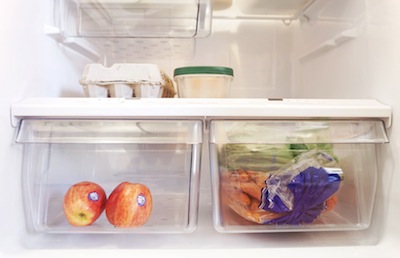
What’s the first thing that pops into your mind when you hear the words “humidity drawer”? If you’re like me, the answer might be, “Oh, that’s what those things are called!”
Humidity drawers, or crispers (because they keep your produce nice and crisp!) are the the drawers at the bottom of your fridge. They’re a nice place to store miscellaneous produce for most of us, but if used correctly, they can extend the life of your produce and keep everything in tip-top shape for as long as possible.
Setting and filling your humidity drawers
Most humidity drawers, like the ones in this super-simple stainless steel fridge by Insignia or this super-sexy black stainless steel refrigerator by Samsung, can be adjusted with the slide of a tab. (We just moved, but I promise that there’s usually more produce in the house than this!) On the “high-humidity” end, the drawer’s control window is completely closed, trapping the water vapour let off by fruits and veggies inside. On the “low-humidity” end, the drawer’s window is completely open, allowing for air flow between your produce and the rest of the fridge, keeping things nice and dry.
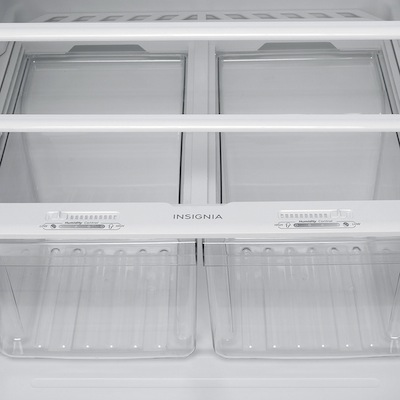 Humidity drawers are also a great way to control the ethylene gas in your fridge. It’s a gas that’s naturally let off by things like apples, and it’ll encourage ripening or spoiling in some (but not all) produce. If you store a couple of apples in a high-humidity drawer with potatoes or strawberries, for instance, the ethylene gas release by your apples will build up in the drawer, causing your berries to either ripen faster and your potatoes to grow eyes. So, if you’re trying to get something to ripen quickly, you can throw them into the high-humidity drawer for a day or two before consuming. If not, you can put your ethylene-emitting produce in your low humidity drawer, and keep your ethylene-sensitive produce separate in your high-humidity drawer.
Humidity drawers are also a great way to control the ethylene gas in your fridge. It’s a gas that’s naturally let off by things like apples, and it’ll encourage ripening or spoiling in some (but not all) produce. If you store a couple of apples in a high-humidity drawer with potatoes or strawberries, for instance, the ethylene gas release by your apples will build up in the drawer, causing your berries to either ripen faster and your potatoes to grow eyes. So, if you’re trying to get something to ripen quickly, you can throw them into the high-humidity drawer for a day or two before consuming. If not, you can put your ethylene-emitting produce in your low humidity drawer, and keep your ethylene-sensitive produce separate in your high-humidity drawer.
In general, produce with a tendency to rot should go in the low-humidity drawer, produce with a tendency to wilt should go in the high-humidity drawer, and both should be kept at least half full for optimal efficiency. (My two apples aren’t really cutting it; I know.) If you’re noticing that your produce is going bad more quickly on weeks when you haven’t had time to do a proper grocery run, this is likely why!
Nearly-empty drawers, like the ones that we’re sporting right now, just don’t have the same effect on produce that full ones have. Not enough water vapour is let off in the high-humidity drawer to keep it moist, and storing something in the empty low-humidity drawer is more or less the same as storing it in the regular fridge body.
The high-humidity drawer
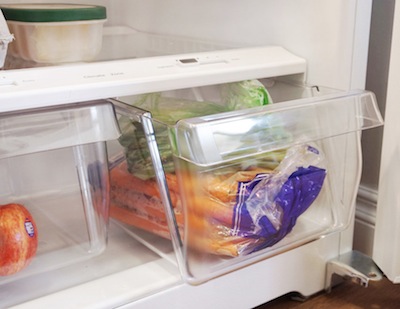 High-humidity drawers are sometimes labelled as vegetable drawers, and in general, they should be used to store veggies and berries. The closed drawer will keep your leafy greens from drying out and will prevent any ethylene-sensitive produce from rotting prematurely.
High-humidity drawers are sometimes labelled as vegetable drawers, and in general, they should be used to store veggies and berries. The closed drawer will keep your leafy greens from drying out and will prevent any ethylene-sensitive produce from rotting prematurely.
A couple examples of fruits and vegetables that belong in this drawer are:
- Broccoli
- Carrots
- Green beans
- Herbs
- Leafy greens
- Strawberries
- Radishes
- Zucchini
- Basically, anything that gets floppy when it dries out!
When it comes to your vegetables, make sure to store them in unsealed containers in your high-humidity drawer. So, if you’ve just come home from the grocery store and everything is wrapped up in plastic, poke a couple of holes in the bags, or transfer them to new containers. High humidity in a drawer is good; super tight, locked-in moisture is bad.
Additionally, for vegetables like asparagus and celery, the high-humidity drawer is a good option–but storing them in the fridge itself is even better. To keep them in peak condition, trim the bottoms and store them upright in a shallow bed of water, like a bouquet of tasty flowers.
The low-humidity drawer
Low-humidity drawers are sometimes labelled as fruit drawers, as fruits tend to let off more ethylene gas and aren’t vulnerable to moisture loss. (When was the last time that you ate a plum and thought, “Wow, this plum totally dried up through its skin”? Yeah.)
A couple of things that you can keep in the low-humidity drawer are:
- Apples
- Avocados
- Ripe bananas (I just learned about this one today; all my life, I’ve had no idea that you could refrigerate bananas without negative consequences!)
- Mangoes
- Stone fruits
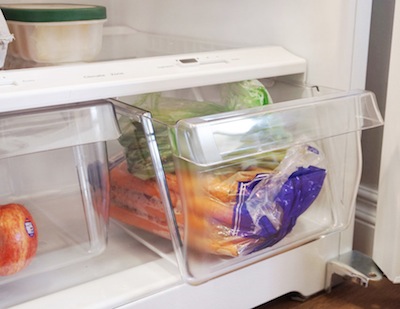
Finally in this list, citrus fruits such as oranges generally don’t require refrigeration at all, and “fruits” like tomatoes do better on the countertop than in the fridge. If you do choose to store them in the fridge–I know we have to keep tomatoes in the fridge now, as our cat has recently developed a strange taste for them and will literally tear through bags to get at tomatoes if they’re left out–then they’ll do best in medium humidity.
As most people keep only a high-humidity and a low-humidity drawer, feel free to keep any medium-humidity items in your low-humidity drawer or in the body of your fridge. For any produce overflow, store them in the body (not the door) of your fridge, but make not to store them close to the freezer! The side or shelf closest to the freezer will often be chillier than the rest of the fridge, and produce can frost over, causing their cell walls to burst and the item in question to go watery and limp.
Take a look at my video for a how-to on using humidity drawers.
If you cook at home a lot and your fridge sees a lot of produce overflow, consider opting for a big fridge like this 4-Door French Door monolith from Samsung. It has two large humidity drawers just like most fridges, but it also has 3 evaporators and humidity controls for the separate zones of your fridge, so you can always turn one of the compartments into a giant-sized humidity drawer. (I’d recommend storing your ethylene gas-producing fruits in the fridge’s humidity drawers and turning the lower half-fridge compartment into a big high-humidity drawer for your selection of leafy greens and other assorted high-humidity produce.)
Most fridges have more than just a couple of drawers, but they’re not all humidity drawers. There’s usually a meat & perishables drawer near the cold centre/top of your fridge for items that will go bad if they get too warm, and there is often space in the warmer fridge door for things that are resistant to perishing, like condiments.
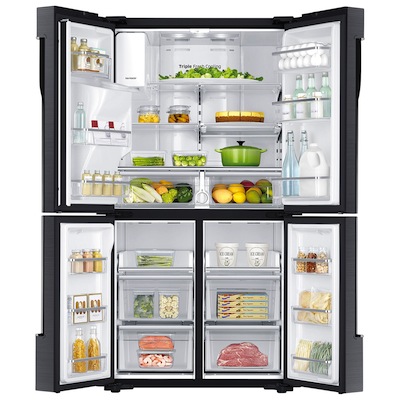
In older fridges, you’ll also see drawers for eggs in the side of the door. Never use these! They’re a convenient place to store your eggs, but they’ll go bad much more quickly when exposed to all that warm air. (Instead, eggs should be stored near the meat or freezer, unlike your produce.)
Finally, for an envy-worthy kitchen that even a food blogger would get excited about, there’s always that Samsung 36″ 27.8 Cu. Ft. French Door Refrigerator with LED Lighting. It has a black stainless steel finish and a FlexZone compartment that can be customized to be fridge, freezer, or produce space, and it features a snazzy FlexZone “drawer” just above the produce. The FlexZone drawer has a temperature-adjustable metal cooling plate of its very own, making it the ideal place to store produce that you’re just about to eat. No one likes getting brain freeze from a mouthful of grapes, but with this high-tech, humidity-controlled fridge, there’s no waiting for your fruit to slowly come back up to an enjoyable temperature before you can set it out for everyone to snack on.
To find the refrigerator that’s perfect for you (and your produce-eating habits), look no further than the wide selection of refrigerators available at Best Buy!



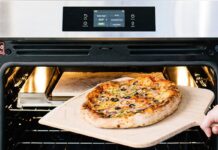
What happens when everthing in the. Fridge is freezing, even when I have turned it down toone
Bananas in the fridge? I had no idea. I’m happy to know this before fruit fly season hits!
Comments are closed.